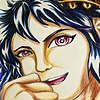HOME | DD
 Saskle — Inktober #1: Poisonous
Saskle — Inktober #1: Poisonous

#archer #arrow #bow #ink #inkdrawing #poisonarrow #poisonous #tonedpaper #warrior #inktober #bowandarrow #inktoberchallenge #tonedpaperart #inktober2018
Published: 2018-10-01 20:58:23 +0000 UTC; Views: 282; Favourites: 17; Downloads: 0
Redirect to original
Description
And Inktober has begun again! This year I will only draw every other day, as I have so many projects going on right now! XDUnfortunately I don't have a scanner where I live now, so a lot of Inktober drawings will be photos for now. I might update them with scans later on.







Related content
Comments: 15

I like your choice of angle, it's not the easiest one especially given the bow hand! But it's like from an action film or something, very catchy! 
👍: 0 ⏩: 1

Thanks! That angle sure wasn't easy to get right, even with reference. >< I'm glad you like it!
You do archery? That's so cool!
👍: 0 ⏩: 1

It does seem a tricky one. I have trouble understanding the foreshortening sometimes, and especially with the bow hand because it's supposed to be straight but when you look at it in a certain angle it just doesn't seem so any more like here, it looks as if the hand made a curve though in reality it doesn't. In order to get it right you must not only understand the technique itself but also the laws of 3D-ness. XD
Haha, my equipment is currently quite modern with the longbow, but I'm hoping to move to traditional gear to get more challenge, lol. And because, I just want to know how it feels to shoot the way the people did back in the years. Never thought that would lead me to a bow workshop though well, it's nice though learning this and that about the behaviour of wood types. ^^
👍: 0 ⏩: 1

Yeah, foreshortening is terrible XD Without the reference I used I would be nowhere! I have often trouble to imagine the shape in 3D..
It would be amazing to be able to shoot with a traditional bow indeed. 
👍: 0 ⏩: 1

Indeed. ^^
Honestly, neither did I before I going to the course. ^^ it turned out quite informative, even the first time. He told us that with the leaf bearing trees, the more the wood has those darker stripes (spring growth) and the thicker they are the more durable the wood is. But it's apparently upside down with the conifer trees, so there you aim for the winter growth instead. You must also look how the fibres go, and the important thing is to get a wood where the fibres go as much to the same direction as possible. If they go against each other or are too curvy, well, that's not going to make a good bow. If it's too bad, it'll break on the first bend. The branch spots are also difficult because the wood won't bend from there. And if the wood makes a curve, we'll go along it; hence why each traditional bow is truly unique and may sometimes have slight curves on the limbs. Haha, I just learnt the image of comics and films with straight, smooth, symmetric limbs may not always be the case. XD The most important thing is to think about the mechanic of the bow. A small limb curve, won't matter if the string can be tied so that it goes from the middle and if the limbs bend equally. And the archer's paradox happens, because if it won't work, won't work your bow either.
And he told about archer's paradox (the thing that enables you can shoot where you aim at). Archer's paradox = you aim for the target, but while aiming your arrow isn't pointing at what you're aiming to hit. When you release, the arrow is slightly pointing off your target. Well, there's the grip in your way (with traditional bows) so how could you possibly point straight? You can't. In the release: The string generates the energy stored in the limbs (when you drew it) to the arrow. It pushes the arrow and on the push the arrow bends to the left (at least if we shoot like this guy here in your drawing). This first bend enables the arrow to sort of go around the grip (this is what you need to get it to your target!), after that it bends to right, and then again left and so on... it continues this bending motion while flying through the air, spinning as well, too. The fletching kind of stabilises the flight. Because of different wood types, arrows also bend differently. The flexible ones suit traditional bows better, surprise. However, this also means the more flexible, the more they bend. So, when you shoot in the forest, aiming for the arrow to go through a narrow gap... it may not always work. It's funny, because mostly your eyes won't detect it, an arrow flies too fast to notice it. But suddenly it just hits a tree on its way and you see wood pieces exploding. Congrats, the arrow just got destroyed because you aimed for a route too narrow. Because of the bending, it didn't made it through... 
It's easier to understand through slow motion videos:
www.youtube.com/watch?v=O7zewt…
www.youtube.com/watch?v=-skT7S…
www.youtube.com/watch?v=96KGWC… (this demonstrates well what happens if the spine isn't fit for the bow's pounds, the mind-blowing stuff of this video happens at the end (~5:12). 
As for the material, it depends on your region. Trees growing in wet and cold areas will do better there than in the hot desert and vice versa. So I guess, the English yew, could do poorly in the heat of Sahara, haha. Sometimes, the climate differences are so great the bow may even break. It's organic material, after all! You must consider many factors! :'D But as an example of something that's listed on the notes:
'native': rowan, hazel, maple, European ash (I'm using that), apple tree...
foreign: hornbeam, bambu, cherry (on of us is using this), hikkori, black locust, yew...
👍: 0 ⏩: 1

That's super interesting! You explained it quite well, I understood what you meant before I looked at the videos. 
I don't know what else to add to your elaborate explanation XD
👍: 0 ⏩: 0

...wasn't Inktober like... not that long ago?
OH MY GOD HAS IT BEEN A YEAR ALREADY SINCE I COMMENTED ON YOUR LAST INKS?? D8
PS. Long distance injection FTW.
👍: 0 ⏩: 1

Haha, time flies when you're having fun!
injection XD
👍: 0 ⏩: 1

I guess so!!
Well I suppose if someone is trying to escape their injection, this becomes an option...
👍: 0 ⏩: 1

Now I have an image of doctors trying to shoot kids with injection needles in my head XD
👍: 0 ⏩: 1

I have the image of little school children running and screaming for their lives, and a bunch of doctors are literally firing syringes with bows... xD
👍: 0 ⏩: 1

Nothing could be more glorious~ xD
👍: 0 ⏩: 0
























